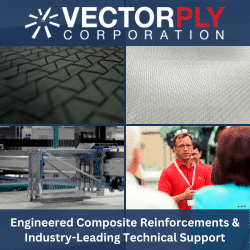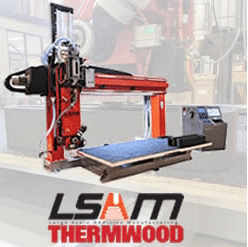
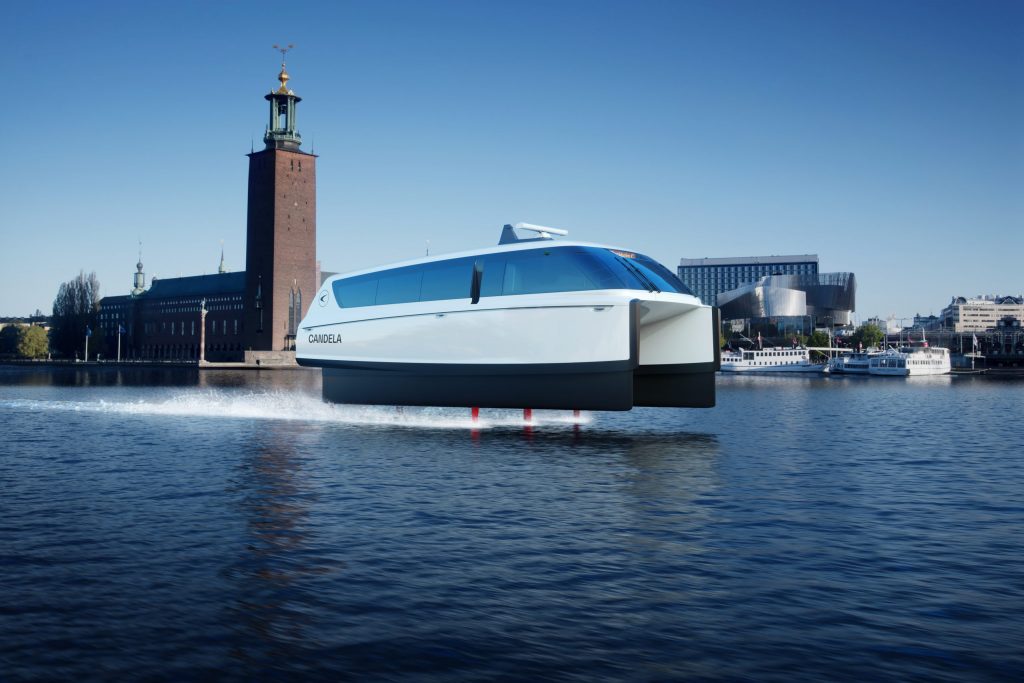
Working on the Water
When people think of the marine industry, they typically envision pleasure yachts. While recreational boats dominate the market, there’s a less heralded segment that’s worthy of attention – workboats.
The global industrial workboats market reached $2.5 billion in 2022 and is forecast to exceed $4.6 billion by 2032, according to an analysis by market research firm Fact.MR. The report attributes several factors to anticipated growth, including:
- The push to minimize the carbon footprint of shipping fleets, aided by developments in hybrid technology and electric vessels.
- Increased demand for floating offshore wind energy, which will require workboats to complete construction projects.
- The drive to design workboats that are versatile and efficient, employing advanced technology and materials.
Companies involved in the market are motivated by the potential, while recognizing the unique needs of working boats.
“When a boat has to go to work, it needs to be functional and last a long time. It needs to make a business case,” says Eric Jambor, lead project engineer at Janicki Industries, an engineering and manufacturing firm in Sedro-Woolley, Wash. “For a long time, the marine industry played it safe, but we’re now starting to push the envelope of what can be done for the cost invested. That’s very exciting.”
There are many kinds of boats laboring on the water, several of which are noted in the sidebar on page 11. In this article, we share stories about two of them – electric ferries and autonomous vessels. Both highlighted applications rely on composite materials to promote environmentally friendly vehicles powered by electricity, solar panels or wind energy.
Electric Shuttles to Replace Diesel Ferries
Candela, a manufacturer of hydrofoil electric boats based in Sweden, is trialing an innovative ferry from the Stockholm suburb Ekerö to the city center that cuts travel times from 55 minutes to 25 minutes. The 30-passenger Candela P-12 Shuttle can travel up to 60 nautical miles at 25 knots on one charge thanks, in part, to three computer-guided CFRP hydrofoils that extend from under the hull, lifting the boat out of the water and decreasing drag.
Candela developed the P-12 Shuttle as an alternative to conventional, large diesel ferries.
“The average passenger load factor in Stockholm is 17%, meaning that a 350-passenger vessel carries on average 50 persons,” says Mikael Mahlberg, head of public relations and communications at Candela. “Our proposition is to replace these few and inefficient polluting shuttle ferries with a greater number of P-12s, which would lead to more frequent departures and faster travel times while cutting operational costs.”
Mahlberg refers to the shuttles as “a bus line system on the water.” The first P-12 Shuttle was slated to begin service in the fall, followed by six months of trials and full insertion into the public transport system in the spring of 2024.
All the structural components on the 12-meter-long shuttle, from the hydrofoils to the hull, are made from CFRP. The components, which are vacuum infused, feature multiaxial carbon fiber fabric ranging from 400 to 800 grams per square meter and epoxy resin.
Candela’s commitment to electrification of waterborne transport required it to overcome technical challenges.
“Conventional vessels use so much energy going through the water,” he says. “For electrification to happen without substantial subsidies and across many routes, you need to make vessels that have great performance, long range, better economy of features and new features to give advantages over current diesel vessels.”
Candela’s hydrofoil technology is the key ingredient to economical electrification of the shuttles. Mahlberg says the hydrofoils cut energy use by 80% and are compatible with current battery technology. In addition, the shuttle relies on a smaller battery than other electric passenger ships of the same size – approximately 260 kilowatt hours (kWh) – which Mahlberg says makes it much less expensive to purchase and 60% to 70% cheaper to operate than diesel ferries.
“Since it is so efficient, it doesn’t require large investments in charging infrastructure,” he says. “An automobile-style DC charger at the route’s end station is enough.”
Prior to developing the P-12 Shuttle, Candela made a series of leisure boats, which provided invaluable experience in the engineering and production of CFRP vessels. But the scale and constant need for shedding weight presented obstacles in making shuttles for public transportation.
“In our niche – coastal vessels – serial production is mostly unheard of. An operator might order one to three units with the same design, but the next operator comes along and orders another design specific to their needs,” says Mahlberg. “We’ve tried to make a boat that works for many cases and dock heights. By making a standardized model, we can drive down costs.”
Candela hopes its P-12 Shuttle will bring back waterborne mobility to urban areas and compete favorably with cars and buses.
“We’re offering a solution for replacing gas-guzzlers with a sustainable vessel that is faster and much more comfortable for passengers, while offering cost savings over conventional vehicles,” says Mahlberg.
Marine Drones for Data Collection
When Hurricane Idalia traveled up the Gulf Coast of Florida sustaining 125 mph winds, it unmoored and destroyed small boats. But it wasn’t a match for a couple of uncrewed surface vehicles (USV) in its path. Saildrone’s USVs, made primarily from composite materials and stainless steel, gathered data for the National Oceanic and Atmospheric Administration (NOAA) to help it better predict storms.
NOAA is just one of Saildrone’s customers, which include a wide range of government agencies, universities, foundations and research groups that require ocean data.
“Saildrone’s mission is to find ways to sustainably explore, map and monitor the world’s oceans,” says Mark Cuyler, chief operating officer. “We offer a great platform to go places that are hard to reach and be there for long durations.”
The company has three classes of vehicles, all of which feature a patented wind propulsion system and solar-powered meteorological and oceanographic sensors to perform long-range data collection missions. The first USV the company developed was the 7-meter-long Explorer. It includes a lead keel and a GFRP hull and wing. The USV runs 100% on renewable energy, using solar panels to charge a lithium battery that operates the vehicle’s systems and sensors.
The 10-meter-long, hybrid Voyager class was introduced in 2022 and features a GFRP hull and wing and a keel made from lead and stainless steel. In addition to the battery, it includes a small diesel generator to increase endurance. “It’s a step function improvement to the first USV,” says Cuyler. “There is a base set hull with modular payload boxes that can be taken in and out without having to reconfigure the hull.”
Saildrone is currently developing its third platform, the 20-meter-long, diesel/electric Surveyor. The hull is aluminum, and the 44-foot-tall wing is GFRP. “The Surveyor is large enough to go after a customer base that needs something more rugged and heavy to go to really challenging areas of our globe,” says Cuyler.
Composites are an integral part of the multi-material autonomous vehicles. One of the biggest benefits is durability.
“We’re in an ocean environment, so corrosion is a huge factor,” says Cuyler. “Everything on these vehicles corrodes if it’s not composite.”
A second advantage of composites is their design flexibility. “We are able to create shapes and configurations that are designed for aerodynamics and easy to manufacture,” says Cuyler. “You can achieve shapes with glass fiber that you can’t do with metals.” In addition, composite materials allow Saildrone to rapidly iterate different designs, introducing new capabilities or adding sensors.
Janicki Industries is one of Saildrone’s manufacturing partners on the Voyager. It provides the upright rigid wing, deck hatches and a keel fairing made from composite materials, as well as some stainless steel components, including the keel fin and payload plates.
The composite components are primarily out-of-autoclave prepregs – a mix of GFRP and CFRP in selective spots, some foam cored and some solid laminate. Janicki uses standard aerospace processes, including temperature-rated carbon tools and an NC-Ply™ kit for the laminate and core. Components are laid up by hand, vacuum bagged and cured in an oven.
However, being a trusted partner isn’t just about delivering products; it’s a true collaboration. Saildrone provided an initial design package for the Voyager, then Janicki built the tools and vehicle components. The company offered invaluable manufacturing support along the way.
“What are ways we can reduce the cost? Where can we look at reducing the complexity of the manufacturing? Janicki is really good at bringing that information back to us: If you tweak this or move that, you can eliminate a part that isn’t necessary, which saves on cost and improves efficiency,” says Cuyler.
The companies also worked together to standardize processes, which has helped Janicki maintain its targeted 95% first pass yield rate. For example, the mast requires several concentric stations with bushings that need to be installed and bonded in place, all relative to the wing.
“We leveraged our aerospace capabilities and our large 5-axis machines to get a really solid fixture that we don’t have to think about,” says Jambor. “We don’t have to measure everything every single time. It’s repeatable, it’s accurate and it works.”
Janicki has recently begun work on the new Surveyor platform, providing design guidance to Saildrone’s engineers. While Saildrone is building the wings inhouse, Janicki will fabricate the trim tail off the back of the wing.
“We are all working together to help achieve Saildrone’s goals,” says Bryan Harris, program manager for Janicki’s Industrial Division. “We aren’t just trying to check boxes and fulfill a contract. We are trying to help them be successful.”
Susan Keen Flynn is managing editor of Composites Manufacturing magazine. Email comments to sflynn@keenconcepts.net.
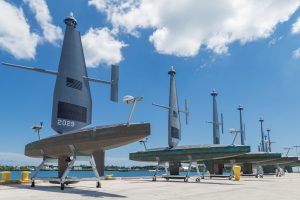
Saildrone is working with the U.S. Navy to develop a hybrid fleet for long-term operations of unmanned and manned forces.
Photo Credit: Saildrone
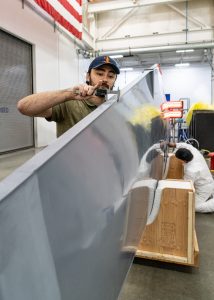
Orion Collins, standing, and Tino Zenon-Esteba from Janicki Industries perform final inspection and ship preparations on a Voyager wing.
Photo Credit: Janicki Industries

SUBSCRIBE TO CM MAGAZINE
Composites Manufacturing Magazine is the official publication of the American Composites Manufacturers Association. Subscribe to get a free annual subscription to Composites Manufacturing Magazine and receive composites industry insights you can’t get anywhere else.


